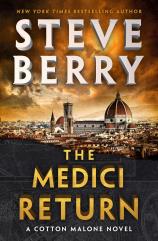Excerpt
Excerpt
The Medici Return: A Cotton Malone Novel

CHAPTER ONE
DILLENBURG, GERMANY
SUNDAY, JUNE 29
12:40 A.M.
COTTON MALONE HAD COMMITTED BURGLARY BEFORE.
Many times, in fact.
Just not in such an august place.
He stood inside a four-hundred-year-old residence, built of olden brick and stone, first erected during the 17th century at a time when the German states, Sweden, and Poland were beset by religious conflict. Catholics fought Protestants in a long and destructive Thirty Years War. The building around him was a picturesque relic of that violent history, which somehow escaped razing by the Protestants. It likewise survived later conflicts, including both world wars. It remained the rural home of a cardinal, owned by the Archdiocese of Cologne, whose duly authorized representatives in Rome had granted Cotton permission to surreptitiously enter the premises.
So, technically this wasn’t a burglary.
Still, it definitely felt like one.
Germany possessed nine cardinals. Three were beyond the age of eighty, meaning they were ineligible to attend the next conclave and vote for a new pope. Six remained active, the youngest, Jason Cardinal Richter, served as the current archbishop of Cologne. The house served as Richter’s private retreat, a place outside the city that he enjoyed from time to time.
Dillenburg sat about seventy miles east of Cologne, in a narrow valley cut by the River Dill. The town was one of those out of the way places that had once been much more important. Its healing spring and brine works, renovated a few years ago, were back open for visitors, which helped with tourism. Once a wooden castle dominated the hill above the town but all that remained were ruins, along with an impressive stone lookout tower that had become a local landmark. The cardinal’s residence sat in sight of the watchtower, atop the thousand-foot hill, with a spectacular view of the valley below.
Cotton was surreptitiously working with the Swiss Guard, on special assignment through the Magellan Billet. His former boss, Stephanie Nelle, had called a few days ago asking for help. An extraordinary situation was developing at the Vatican. Six defendants were on trial for fraud, embezzlement, corruption, money laundering and abuse of office. The charges centered around the Church’s multi-million euro purchases of investment properties located throughout Ireland and England. The deal, investigators argued, was nothing more than a way for the defendants to launder money and refinance their own debts through embezzled funds.
Two of the defendants were monsignors, employed within the Secretariat of State. Two more were former heads of the Vatican’s internal financial overseer, charged with making sure frauds never happened. The final pair were an Italian financier and an investment manager. The whole thing seemed a wide-ranging conspiracy better suited for spy novels. Certainly not something that might happen within the Holy See.
Thankfully, as with most complex criminal enterprises, mistakes had been made which led to its discovery. A special Vatican court had been empaneled to try the defendants, the judges selected by the pope from among an array of former-Italian prosecutors. The trial itself had started months ago, the evidence trickling out through a parade of witnesses at a snail’s pace. It was being held inside a spacious hall within the Vatican Museums to accommodate the large amount of media and spectators. Two weeks ago things had taken an unusual turn when one of the defendants, a monsignor from the Secretary of State’s office, offered prosecutors a deal. In return for immunity he would provide them with incriminating information on one, so-far unnamed, individual.
A prince of the Church.
Jason Cardinal Richter.
A secret proffer of information had occurred to prosecutors and the Swiss Guard had been quietly ordered to confirm its veracity. The trial itself had been recessed on the pretense of the court performing a partial review of the evidence so as to be able to rule on motions filed by the defendants. A totally plausible scenario, as similar recesses had also occurred. So sensitive was the situation that outside help had been requested through the United States attorney general, who involved the Magellan Billet, which had led to Stephanie calling Copenhagen.
“We need a sneak and peek. There are too many eyes and ears at the Vatican. No way to keep something like this secret. So they want us to quietly check it out. How tough could it be? He’s a cardinal, not a mafia boss. Just see what’s there.”
Right. How hard could it be?
The actual entry into the house had been simple. The locks were easy to pick and the old building came with no cameras or alarms. But why would it? It was more a get-away than a residence, kept by the diocese as a perk for its resident cardinal. A place to enjoy on the weekends or in summer. No one lived there full time, but the information they’d been given stated that Cardinal Richter used the house as a repository for, if the informant was to be believed, about four hundred thousand euros in cash. Far more money than any prelate could have ever legitimately accumulated.
He stood at the top of the stairs on the third-floor landing. The stale air carried a musty smell. The walls were heavy plaster, painted a soft cream, broken by arches, the ceilings coffered wood, the mullion window in the alcove at the end of the hall leaden and in need of cleaning. He assumed this place harbored lots of nooks and crannies. One in particular was of interest. A unique anomaly. The 15th century equivalent of a safe room.
When the Protestant armies rolled through Germany during the Thirty Years War Catholic priests were a favorite target. They liked to hang them. To avoid that priests took to hiding, many inside homes where specially concealed compartments, just big enough for them to squeeze into, were secretly constructed. They were artfully contrived not only for the priest, but also as a place where vestments and sacred vessels could be hidden away. Those secret compartments had been built into fireplaces, attics, staircases, concealed in walls, under floors, and behind wainscoting, designed to blend in with the architecture and escape detection.
They even had a name.
Priest holes.
This olden house had its own. His task was to open it, take a look, and photograph what he found.
A classic sneak and peek.
He stepped down the hall, his steps cushioned by a soft carpet runner, and entered one of the guest bedrooms. Fluted columns jutting from the walls filled the corners. All part of the décor to go along with more moldings that adorned the room, everything glazed with a thick coat of paint. He’d been told that what he sought would be to the right of the door.
He studied the column and caressed the slick surface, the wood painted to a high sheen. The mechanism to release the panel was supposedly at the bottom. Not olden. Instead it had supposedly been updated a while back by Cardinal Richter to be more reliable. He crouched down, found the hole beneath the base, and pushed on the metal inside.
He heard a soft click.
The front part of the fluted column separated from the rest.
Okay. Step one done.
And though he was no longer a first stringer in the intelligence business, he still knew how to come off the bench and play the game. Ben Franklin said it best. Distrust and caution were the parents of security. And, if nothing else, he was cautious.
Which told him not to open the panel any further.
A dark crack about a half-inch wide had formed from where the wood had separated. Interestingly, it had not swung out any further. Was that significant? Only one way to know.
He found his phone—Magellan Billet issued, a gift from Stephanie—and activated the light. He aimed the beam into the crack and started examining the opening, slowly moving upward toward the top.
About halfway he stopped and felt a familiar surge in his pulse.
“Gotcha,” he muttered.



